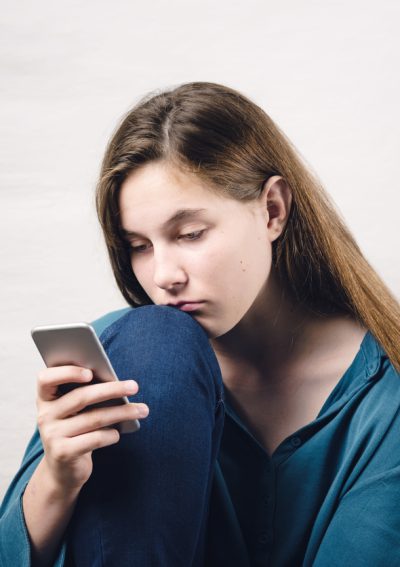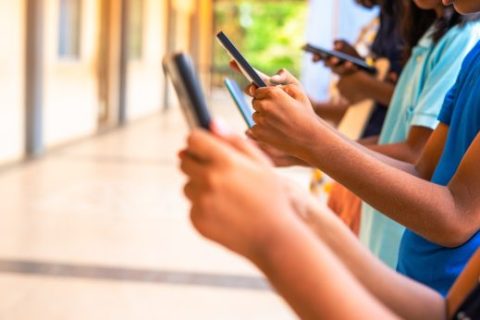How Social Media Affects Teenagers
Research suggests some teen social media use, particularly engagement with content promoting negative body images or self-harm, may worsen depression, sleep disruption and eating disorders. Data also suggests potential benefits for teens, such as finding support, community and space for creativity.

Positive Effects of Social Media on Teens
Results from surveys show that teens see their own social media experiences as mostly positive. They view it as a tool for community, support and creative expression.
In fact, Pew Research Center’s 2022 survey found that 80% of teens reported feeling more connected to friends with social media use. While parents express concern about their children’s social media use, teens paint a nuanced picture of their lives on these platforms.
Harvard researcher Mesfin A. Bekalu found, “Routine social media use may compensate for diminishing face-to-face social interactions in people’s busy lives. Our findings suggest that the ways that people are using social media may have more of an impact on their mental health and well-being than just the frequency and duration of their use.”
Community and Acceptance
In Pew’s research, 58% of teens said social media makes them feel more accepted. Stable relationships lead to social-emotional skills and build resilience. They also prevent loneliness.
Loneliness and isolation can lead to anxiety, depression or high blood pressure. According to one recent study, one-to-one communication and mutual online friendship mitigated feelings of loneliness and stress during the pandemic.
Support
Of surveyed teens, 67% said social media makes them feel they have people to support them through tough times. This may have a direct connection to content related to mental health.
The #MentalHealth hashtag, for example, is used in millions of posts. Sharing relatable content, influencers and therapists on social media have helped reduce mental health stigmas, encouraging open dialogue for teens. It’s important to remember social media isn’t a substitute for an appointment with a therapist.
Expression and Creativity
Of surveyed teens, 71% said social media provides a place to show their creative side. Research shows that this plays an integral role in teens’ personal expression.
One study found that those who think more creatively, according to one scale, tend to spend less time on smartphones. However, people with real-life creative accomplishments tended to be more active on social media. Authors suggest that social media may provide social support and praise, helping people accomplish creative goals.
Negative Effects of Social Media on Teens
Statistics about social media abuse have shed light on several issues. As The Wall Street Journal reported, Meta, the parent company of Instagram, conducted its own research over three years and presented findings to Congress. Researchers found that 32% of teen girls said “that when they felt bad about their bodies, Instagram made them feel worse.”
They also reported that “Teens blame Instagram for increases in the rate of anxiety and depression.” Of teens reporting suicidal thoughts, 6% in the U.S. and 13% in the U.K. attributed those thoughts to their Instagram usage.
Meta, however, says of the reporting, “Contrary to The Wall Street Journal’s characterization, Instagram’s research shows that on 11 of 12 well-being issues, teenage girls who said they struggled with those difficult issues also said that Instagram made them better rather than worse. This research, like external research on these issues, found teens report having both positive and negative experiences with social media.”
Misinformation and Disinformation
Misinformation is the unintentional spreading of incorrect information, whereas disinformation is published to deliberately mislead users. Children may be particularly vulnerable as impulse control is still developing.
One study found that teens are more likely to share content if it connects with their interests, regardless of whether or not it’s true. The appearance of newsworthy information is more of a factor in whether teens are likely to share it than the content.
Sleep Disruption and Addiction
Research shows that heavy daily social media use increases the risk of decreased, disrupted and delayed sleep. Sleeplessness is associated with depression, memory loss and poor academic performance.
Psychologists estimate that as many as 5%-10% of Americans meet the criteria for social media addiction. Scientists find overuse creates a stimulation pattern in the brain like other addictive behaviors.
One study found that receiving “likes” on social media creates a rush of dopamine similar to winning money or eating chocolate. Social media harm from overuse is the subject of ongoing research.
Cyberbullying
Cyberbullying involves behaviors such as offensive name-calling, spreading false rumors, receiving and sharing explicit images without consent and physical threats. While a significant number of students report bullying from classmates predominantly happens at school, nearly half of U.S. teens report being bullied or harassed online, and often strangers are responsible.
Physical appearance is reportedly a common subject for cyberbullies. Older teen girls are especially likely to report being targeted for this reason.
Depression
Some studies show a correlation between social media and depression. Teens who spent the most time on Instagram and Facebook were shown to have 13%-66% higher rates of reported depression, though correlation is not the same as causation.
Some studies show that while social media can help connect those physically isolated, which was borne out during the pandemic, it can exacerbate issues such as fear of missing out, or FOMO. Self-comparisons to others’ photos may also increase the risk of depression.
Eating Disorders
The relationship between social media and eating disorders is complex. As Meta’s research found, teen girls already experiencing body image issues reported Instagram made them feel worse. However, 22% said it made them feel better and 45.5% said it didn’t make a difference.
Another recent study of 3,800 young people surveyed over five years reported an association between social media use and lower self-esteem. The researchers found self-esteem to be a significant mediating factor between screen time and eating-related symptoms.
How Can Parents Protect Their Teens?
Parents should consider their child’s individual personality and maturity. Talk openly and honestly about social media and protection from social media harm.
- Set Time Limits. The World Health Organization recommends limited screen time for young children.
- Talk About Misinformation. Discuss how to think critically about media and vetting sources.
- Choose Positive Sources. Direct teens to body-positive-focused accounts that counter negative messaging.
When they’re ready, let children try using one social media app with your guidance. Bear in mind that most social media platforms prohibit children under 13 from creating their own accounts.
Tips to Break Addiction
Creating boundaries around use can ease teens’ social media addiction. Speak to your child’s doctor or therapist if you have concerns about their social media use.
- Explain why a behavior is problematic.
- Set time limits, goals and boundaries that align with your family’s values.
- Turn off devices and notifications at the dinner table and at bedtime.
- Plan family activities, such as volunteering and engaging in community activities together.
- Follow your children’s social media accounts.
Those who have experienced serious harm from social media use have filed social media lawsuits. These suits allege that social platforms have worsened mental health and behavioral disorders and created issues related to social media overuse.
27 Cited Research Articles
Consumernotice.org adheres to the highest ethical standards for content production and references only credible sources of information, including government reports, interviews with experts, highly regarded nonprofit organizations, peer-reviewed journals, court records and academic organizations. You can learn more about our dedication to relevance, accuracy and transparency by reading our editorial policy.
- Mass General Brigham McLean. (2023, January 18). The Social Dilemma: Social Media and Your Mental Health. Retrieved from https://www.mcleanhospital.org/essential/it-or-not-social-medias-affecting-your-mental-health
- Lam, T. et al. (2022, December 25). College students and cyberbullying: how social media use affects social anxiety and social comparison. Retrieved from https://www.cell.com/heliyon/fulltext/S2405-8440(22)03844-0
- Demircioğlu, Z. (2022, December 16). Antecedents of problematic social media use and cyberbullying among adolescents: attachment, the dark triad and rejection sensitivity. Retrieved from https://link.springer.com/article/10.1007/s12144-022-04127-2
- Anderson, M. et al. (2022, December 15). Teens and Cyberbullying 2022. Retrieved from https://www.pewresearch.org/internet/2022/12/15/teens-and-cyberbullying-2022/
- Holcombe, M. (2022, November 16). Teens say their experience on social media is better than you think. Here’s why. Retrieved from https://www.cnn.com/2022/11/16/health/teens-social-media-pew-survey-wellness/index.html
- Pew Research Center. (2022, November 16). Connection, Creativity and Drama: Teen Life on Social Media in 2022. Retrieved from https://www.pewresearch.org/internet/2022/11/16/connection-creativity-and-drama-teen-life-on-social-media-in-2022/
- Livet, A. et al. (2022, November 7). Pathways from adolescent screen time to eating related symptoms: a multilevel longitudinal mediation analysis through self-esteem. Retrieved from https://www.tandfonline.com/doi/abs/10.1080/08870446.2022.2141239?journalCode=gpsh20
- Bozzola, E. et al. (2022, July 25). The Use of Social Media in Children and Adolescents: Scoping Review on the Potential Risks. Retrieved from https://www.mdpi.com/1660-4601/19/16/9960
- Nagata, J. et al. (2022, July 12). Social Epidemiology of Early Adolescent Cyberbullying in the United States. Retrieved from https://www.academicpedsjnl.net/article/S1876-2859(22)00347-3/fulltext
- Valkenburg, P. (2022, April). Social media use and its impact on adolescent mental health: An umbrella review of the evidence. Retrieved from https://www.sciencedirect.com/science/article/pii/S2352250X21001500?via%3Dihub
- Philips, L. (2022, March 25). The rise of counselors on social media. Retrieved from https://ct.counseling.org/2022/03/the-rise-of-counselors-on-social-media/
- Marciano, L. et al. (2022, February 1). Digital Media Use and Adolescents' Mental Health During the Covid-19 Pandemic: A Systematic Review and Meta-Analysis. Retrieved from https://www.frontiersin.org/articles/10.3389/fpubh.2021.793868/full
- Vaingankar, J. (2022). Social Media–Driven Routes to Positive Mental Health Among Youth: Qualitative Enquiry and Concept Mapping Study. Retrieved from https://pediatrics.jmir.org/2022/1/e32758
- Raychoudhury, P. (2021, September 26). What Our Research Really Says About Teen Well-Being and Instagram. Retrieved from https://about.fb.com/news/2021/09/research-teen-well-being-and-instagram/
- Caron, C. (2021, September 21). Worried About Your Teen on Social Media? Here’s How to Help. Retrieved from https://www.nytimes.com/2021/09/21/well/family/teens-social-media-help.html
- Strauss, E. (2021, September 17). What body positivity means to today’s teens. Retrieved https://www.cnn.com/2021/09/13/health/teen-body-positivity-wellness/index.html
- Wells, G. et al. (2021, September 14). Facebook Knows Instagram Is Toxic for Teen Girls, Company Documents Show. Retrieved from https://www.wsj.com/articles/facebook-knows-instagram-is-toxic-for-teen-girls-company-documents-show-11631620739
- Harris, M. (2021, June 25). How social media is changing the way we think about mental illness. Retrieved from https://www.nami.org/Blogs/NAMI-Blog/June-2021/How-Social-Media-Is-Changing-the-Way-We-Think-About-Mental-Illness
- Strauss, V. (2020, October 22). Teaching kids to spot misinformation on social media – and whether enough is being done to get rid of it. Retrieved from https://www.washingtonpost.com/education/2020/10/22/teaching-kids-spot-misinformation-social-media-whether-enough-is-being-done-get-rid-it/
- Herrero-Diz, P. et al. (2020, August 28). Teens’ Motivations to Spread Fake News on WhatsApp. Retrieved from https://journals.sagepub.com/doi/full/10.1177/2056305120942879
- Vidal, C. et al. (2020, February) Social media use and depression in adolescents: a scoping review. Retrieved from https://www.ncbi.nlm.nih.gov/pmc/articles/PMC7392374/
- WHO. (2019). Guidelines on Physical Activity, Sedentary Behaviour, and Sleep For Children Under 5 Years of Age. Retrieved from https://apps.who.int/iris/bitstream/handle/10665/311664/9789241550536-eng.pdf
- Gilbert, S. (2019, November 18). The Importance of Community and Mental Health. Retrieved from https://nami.org/Blogs/NAMI-Blog/November-2019/The-Importance-of-Community-and-Mental-Health
- U.S. Department of Education. (2019). Student Reports of Bullying. Retrieved from https://nces.ed.gov/pubs2019/2019054.pdf
- Anderson, M. and Jiang, J. (2018, November 28). Teens and their experiences on social media. Retrieved from https://www.pewresearch.org/internet/2018/11/28/teens-and-their-experiences-on-social-media/
- Ricci, J. (2018, June 28). The Growing Case for Social Media Addiction. Retrieved from https://www.calstate.edu/csu-system/news/Pages/Social-Media-Addiction.aspx
- Sherman, L. et al. (2016, July.) The Power of the Like in Adolescence: Effects of Peer Influence on Neural and Behavioral Responses to Social Media. Retrieved from https://pubmed.ncbi.nlm.nih.gov/27247125/
Calling this number connects you with a Consumer Notice, LLC representative. We will direct you to one of our trusted legal partners for a free case review.
Consumer Notice, LLC's trusted legal partners support the organization's mission to keep people safe from dangerous drugs and medical devices. For more information, visit our partners page.
844-231-3334

